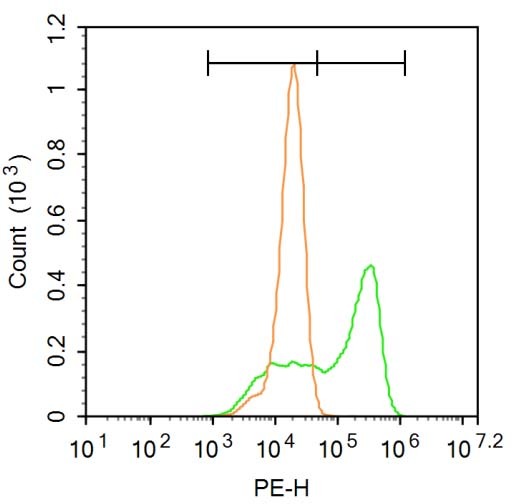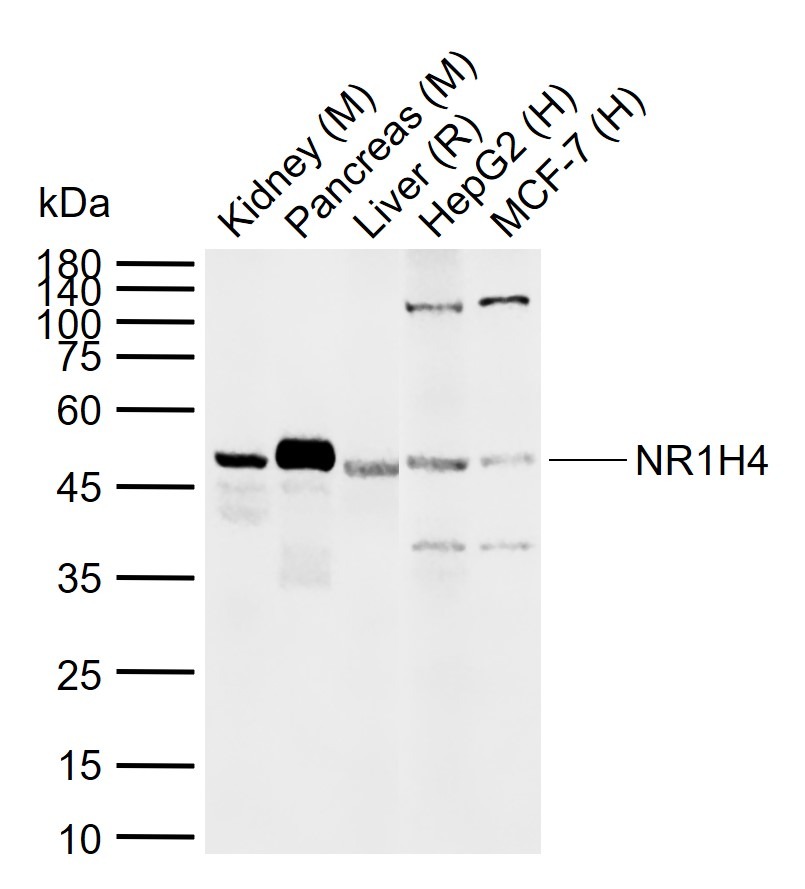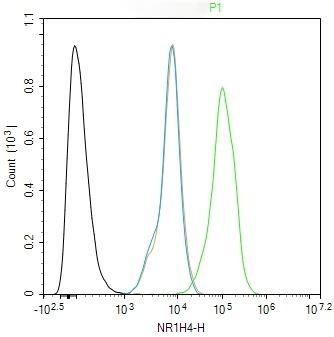Shopping Cart
Remove All Your shopping cart is currently empty
Your shopping cart is currently empty
Anti-NR1H4 Polyclonal Antibody is a Rabbit antibody targeting NR1H4. Anti-NR1H4 Polyclonal Antibody can be used in FCM,WB.
| Pack Size | Price | USA Warehouse | Global Warehouse | Quantity |
|---|---|---|---|---|
| 50 μL | $222 | 7-10 days | 7-10 days | |
| 100 μL | $372 | 7-10 days | 7-10 days | |
| 200 μL | $529 | 7-10 days | 7-10 days |
| Description | Anti-NR1H4 Polyclonal Antibody is a Rabbit antibody targeting NR1H4. Anti-NR1H4 Polyclonal Antibody can be used in FCM,WB. |
| Synonyms | RIP14, nuclear receptor subfamily 1, group H, member 4, HRR-1, HRR1, FXR, BAR |
| Ig Type | IgG |
| Reactivity | Human,Mouse (predicted:Rat,Dog,Pig,Cow,Horse,Sheep) |
| Verified Activity | 1. Blank control: A549. Primary Antibody (green line): Rabbit Anti-NR1H4 antibody (TMAB-01264) Dilution: 1 μg/10^6 cells; Isotype Control Antibody (orange line): Rabbit IgG. Secondary Antibody: Goat anti-rabbit IgG-PE Dilution: 3 μg/test. Protocol The cells were fixed with 4% PFA (10 min at room temperature) and then permeabilized with 90% ice-cold methanol for 20 min at-20°C. The cells were then incubated in 5% BSA to block non-specific protein-protein interactions for 30 min at at room temperature. Cells stained with Primary Antibody for 30 min at room temperature. The secondary antibody used for 40 min at room temperature. 2. Sample: Lane 1: Mouse Kidney tissue lysates Lane 2: Mouse Pancreas tissue lysates Lane 3: Rat Liver tissue lysates Lane 4: Human HepG2 cell lysates Lane 5: Human MCF-7 cell lysates Primary: Anti-NR1H4 (TMAB-01264) at 1/1000 dilution Secondary: IRDye800CW Goat Anti-Rabbit IgG at 1/20000 dilution Predicted band size: 56 kDa Observed band size: 50 kDa 3. Blank control (black line): HepG2. Primary Antibody (green line): Rabbit Anti-NR1H4 antibody (TMAB-01264) Dilution: 2 μg/Test; Secondary Antibody (white blue line): Goat anti-rabbit IgG-AF488 Dilution: 0.5 μg/Test. Isotype control (orange line): Normal Rabbit IgG Protocol The cells were fixed with 4% PFA (10 min at room temperature) and then permeabilized with 90% ice-cold methanol for 20 min at-20°C, The cells were then incubated in 5% BSA to block non-specific protein-protein interactions for 30 min at room temperature. Cells stained with Primary Antibody for 30 min at room temperature. The secondary antibody used for 40 min at room temperature.    |
| Application | |
| Recommended Dose | WB: 1:500-2000; FCM: 2ug/test |
| Antibody Type | Polyclonal |
| Host Species | Rabbit |
| Subcellular Localization | Nucleus. |
| Construction | Polyclonal Antibody |
| Purification | Protein A purified |
| Appearance | Liquid |
| Formulation | 0.01M TBS (pH7.4) with 1% BSA, 0.02% Proclin300 and 50% Glycerol. |
| Concentration | 1 mg/mL |
| Research Background | The steroid receptor superfamily acts through direct association with DNA sequences known as hormone response elements (HREs) and binds DNA as either homo- or heterodimers. The promiscuous mediator of heterodimerization, RXR, is the receptor for 9-cis retinoic acid, and dimerizes with VDR, TR, PPAR, and several novel receptors including LXR (also referred to as RLD-1) and FXR. FXR and LXR fall into a category of proteins termed “orphan receptors” because of their lack of a defined function, and in the case of LXR, the lack of a defined ligand. FXR has been shown to bind a class of lipid molecules called farnesoids. LXR/RXR heterodimers have highest affinity for DR-4 DNA elements while FXR/RXR heterodimers bind IR-1 elements. Both LXR/RXR and FXR/RXR heterodimers retain their responsiveness to 9-cis retinoic acid. |
| Immunogen | KLH conjugated synthetic peptide: human FXR/Bile Acid Receptor NR1H4 |
| Antigen Species | Human |
| Gene Name | NR1H4 |
| Gene ID | |
| Protein Name | Bile acid receptor |
| Uniprot ID | |
| Biology Area | Orphan Nuclear Receptors,Energy Metabolism,Energy Metabolism,Lipid metabolism |
| Function | Ligand-activated transcription factor. Receptor for bile acids such as chenodeoxycholic acid, lithocholic acid and deoxycholic acid. Represses the transcription of the cholesterol 7-alpha-hydroxylase gene (CYP7A1) through the induction of NR0B2 or FGF19 expression, via two distinct mechanisms. Activates the intestinal bile acid-binding protein (IBABP). Activates the transcription of bile salt export pump ABCB11 by directly recruiting histone methyltransferase CARM1 to this locus. |
| Molecular Weight | Theoretical: 56 kDa. |
| Stability & Storage | Store at -20°C or -80°C for 12 months. Avoid repeated freeze-thaw cycles. |
| Transport | Shipping with blue ice. |
| Size | Quantity | Unit Price | Amount | Operation |
|---|

Copyright © 2015-2025 TargetMol Chemicals Inc. All Rights Reserved.